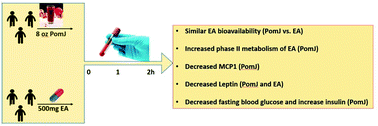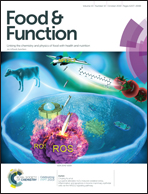Bioavailability and bioactivity of free ellagic acid compared to pomegranate juice
Abstract
Pomegranates are an excellent source of ellagic acid (EA), ellagitannins (ETs), anthocyanins and other phytochemicals. The health benefits of pomegranate (Pom) have been mainly related to its EA and ET content. The objective of the present study was to determine EA bioavailability and bioactivity from different sources such as pure/free or natural form (PomJ). This was a cross-over study with healthy volunteers consuming one dose of EA dietary supplement (500 mg free EA) vs. one serving of PomJ (237 mL, ∼120 mg of EA) in a random order. Our data showed that there was no difference in plasma EA concentration between PomJ and EA intake; however, urinary dimethylellagic acid glucuronide (DMEAG), normalized to creatinine, was significantly higher after the consumption of PomJ compared to EA. Plasma insulin at 1 h increased after PomJ consumption compared to the baseline while decreased after EA consumption compared to the baseline. Plasma glucose decreased below the baseline 2 h after the consumption of PomJ but not EA. Plasma leptin was significantly decreased at 1 and 2 h after PomJ and EA consumption. Plasma MCP1 decreased only after PomJ but not after pure EA consumption. To conclude, one serving of PomJ provided the same level of EA in blood, while the increase in phase II metabolism of EA and an acute suppression of plasma MCP1 were only observed after PomJ consumption, suggesting that other constituents present in PomJ, in addition to EA, are bioactive and likely play a role in regulating EA phase II metabolism.



 Please wait while we load your content...
Please wait while we load your content...